Cold and Wet Island Effect in Mountainous Areas: A Case Study of the Maxian Mountains, Northwest China
Abstract
:1. Introduction
2. Materials and Methods
2.1. Study Area
2.2. Data and Preprocessing
2.3. Methodology
2.3.1. Land Surface Temperature Retrieval
2.3.2. Ts-NDVI Model
2.3.3. Cold and Wet Island Index Calculation
2.3.4. Grading Method of LST and TVDI
2.3.5. Geodetector Model
3. Results
3.1. Annual Variations in Precipitation and Air Temperature
3.2. Monthly and Daily Changes in Air Temperature and Relative Humidity
3.2.1. Analysis of Air Temperature Variations on Monthly and Daily Scales
3.2.2. Analysis of Relative Humidity Variations at Monthly and Daily Scales
3.3. Spatiotemporal Variation Characteristics of LST and TVDI in Mountainous Area
3.3.1. Spatial Distribution Characteristics of LST
3.3.2. Spatial Distribution Characteristics of TVDI
3.4. Analysis of the Cold and Wet Island Effect
3.5. Influencing Factors for the LST
4. Discussion
4.1. Impacts of Land Use Changes on the Cold–Wet Island Effect
4.2. Characteristics of Vegetation Change in Mountainous Area
5. Conclusions
Author Contributions
Funding
Data Availability Statement
Acknowledgments
Conflicts of Interest
References
- Palomo, I. Climate change impacts on ecosystem services in high mountain areas: A literature review. Mt. Res. Dev. 2017, 37, 179–187. [Google Scholar] [CrossRef]
- Viviroli, D.; Weingartner, R.; Messerli, B. Assessing the hydrological significance of the world’s mountains. Mt. Res. Dev. 2003, 23, 32–40. [Google Scholar] [CrossRef]
- Liu, L.; Wang, Z.; Wang, Y.; Zhang, Y.; Shen, J.; Qin, D.; Li, S. Trade-off analyses of multiple mountain ecosystem services along elevation, vegetation cover and precipitation gradients: A case study in the Taihang mountains. Ecol. Indic. 2019, 103, 94–104. [Google Scholar] [CrossRef]
- Wang, J.; Yan, Z. Rapid rises in the magnitude and risk of extreme regional heat wave events in China. Weather Clim. Extrem. 2021, 34, 100379. [Google Scholar] [CrossRef]
- Song, D.; Zhang, X.; Zhou, X.; Shi, X.; Jin, X. Influences of wind direction on the cooling effects of mountain vegetation in urban area. Build. Environ. 2022, 209, 108663. [Google Scholar] [CrossRef]
- Zhang, J.; Shen, X.; Wang, Y.; Jiang, M.; Lu, X. Effects of forest changes on summer surface temperature in Changbai mountain, China. Forests 2021, 12, 1551. [Google Scholar] [CrossRef]
- Wu, W.; Wang, Z.-j. Cooling effect of mountain greenspace on urban heat island in karst mountain city a case study of Anshun. Shengtaixue Zazhi 2021, 40, 855–863. [Google Scholar] [CrossRef]
- Zhou, D.C.; Xiao, J.F.; Frolking, S.; Zhang, L.X.; Zhou, G.Y. Urbanization contributes little to global warming but substantially intensifies local and regional land surface warming. Earths Future 2022, 10, e2021EF002401. [Google Scholar] [CrossRef]
- Yin, T.; Zhai, Y.; Zhang, Y.; Yang, W.; Dong, J.; Liu, X.; Fan, P.; You, C.; Yu, L.; Gao, Q.; et al. Impacts of climate change and human activities on vegetation coverage variation in mountainous and hilly areas in central south of Shandong province based on tree-ring. Front. Plant Sci. 2023, 14, 1158221. [Google Scholar] [CrossRef]
- Shen, M.; Piao, S.; Jeong, S.-J.; Zhou, L.; Zeng, Z.; Ciais, P.; Chen, D.; Huang, M.; Jin, C.-S.; Li, L.Z.X.; et al. Evaporative cooling over the Tibetan Plateau induced by vegetation growth. Proc. Natl. Acad. Sci. USA 2015, 112, 9299–9304. [Google Scholar] [CrossRef]
- Kong, F.H.; Yin, H.W.; James, P.; Hutyra, L.R.; He, H.S. Effects of spatial pattern of greenspace on urban cooling in a large metropolitan area of eastern China. Landsc. Urban Plan. 2014, 128, 35–47. [Google Scholar] [CrossRef]
- Grose, M.R.; Syktus, J.; Thatcher, M.; Evans, J.P.; Ji, F.; Rafter, T.; Remenyi, T. The role of topography on projected rainfall change in mid-latitude mountain regions. Clim. Dyn. 2019, 53, 3675–3690. [Google Scholar] [CrossRef]
- Zeng, Z.; Wang, D.; Yang, L.; Wu, J.; Ziegler, A.D.; Liu, M.; Ciais, P.; Searchinger, T.D.; Yang, Z.-L.; Chen, D.; et al. Deforestation-induced warming over tropical mountain regions regulated by elevation. Nat. Geosci. 2021, 14, 23–29. [Google Scholar] [CrossRef]
- Kattel, D.B.; Yao, T.; Panday, P.K. Near-surface air temperature lapse rate in a humid mountainous terrain on the southern slopes of the eastern Himalayas. Theor. Appl. Climatol. 2018, 132, 1129–1141. [Google Scholar] [CrossRef]
- Obojes, N.; Bahn, M.; Tasser, E.; Walde, J.; Inauen, N.; Hiltbrunner, E.; Saccone, P.; Lochet, J.; Clement, J.C.; Lavorel, S.; et al. Vegetation effects on the water balance of mountain grasslands depend on climatic conditions. Ecohydrology 2015, 8, 552–569. [Google Scholar] [CrossRef]
- Zuo, H.; Lu, S.; Hu, Y.; Ma, Y. Obseravation and numerical simulatin of heterogenous underlying surface boundary layer (i):The whole physical picutre of cold island effect and iverse humidity. Plateau Meteorol. 2004, 23, 155–162. [Google Scholar]
- Hao, X.M.; Li, W.H. Oasis cold island effect and its influence on air temperature: A case study of Tarim Basin, Northwest China. J. Arid Land 2016, 8, 172–183. [Google Scholar] [CrossRef]
- Zhou, Y.; Zhao, H.; Mao, S.; Zhang, G.; Jin, Y.; Luo, Y.; Huo, W.; Pan, Z.; An, P.; Lun, F. Studies on urban park cooling effects and their driving factors in China: Considering 276 cities under different climate zones. Build. Environ. 2022, 222, 109441. [Google Scholar] [CrossRef]
- Sun, R.; Chen, A.; Chen, L.; Lü, Y. Cooling effects of wetlands in an urban region: The case of Beijing. Ecol. Indic. 2012, 20, 57–64. [Google Scholar] [CrossRef]
- Casellas, E.; Bech, J.; Veciana, R.; Ramon Miro, J.; Sairouni, A.; Pineda, N. A meteorological analysis interpolation scheme for high spatial-temporal resolution in complex terrain. Atmos. Res. 2020, 246, 105103. [Google Scholar] [CrossRef]
- Yin, S.; Peng, L.L.H.; Feng, N.; Wen, H.; Ling, Z.; Yang, X.; Dong, L. Spatial-temporal pattern in the cooling effect of a large urban forest and the factors driving it. Build. Environ. 2022, 209, 108676. [Google Scholar] [CrossRef]
- Duan, S.; Ru, C.; Li, Z.; Wang, M.; Xu, H.; Li, H.; Wu, P.; Zhan, W.; Zhou, J.; Zhao, W.; et al. Reviews of methods for land surface temperature retrieval from Landsat thermal infrared data. J. Remote Sens. 2021, 25, 1591–1617. [Google Scholar] [CrossRef]
- Li, Z.L.; Tang, B.H.; Wu, H.; Ren, H.Z.; Yan, G.J.; Wan, Z.M.; Trigo, I.F.; Sobrino, J.A. Satellite-derived land surface temperature: Current status and perspectives. Remote Sens. Environ. 2013, 131, 14–37. [Google Scholar] [CrossRef]
- Song, T.; Duan, Z.; Liu, J.; Shi, J.; Yan, F.; Sheng, S.; Huang, J.; Wu, W. Comparison of four algorithms to retrieve land surface temperature using Landsat 8 satellite. J. Remote Sens. 2015, 19, 451–464. [Google Scholar]
- Qin, Z.; Karnieli, A.; Berliner, P. A mono-window algorithm for retrieving land surface temperature from Landsat TM data and its application to the Israel-Egypt border region. Int. J. Remote Sens. 2001, 22, 3719–3746. [Google Scholar] [CrossRef]
- Jimenez-Munoz, J.C.; Sobrino, J.A.; Skokovic, D.; Mattar, C.; Cristobal, J. Land surface temperature retrieval methods from landsat-8 thermal infrared sensor data. IEEE Geosci. Remote Sens. Lett. 2014, 11, 1840–1843. [Google Scholar] [CrossRef]
- Rozenstein, O.; Qin, Z.; Derimian, Y.; Karnieli, A. erivation of land surface temperature for landsat-8 tirs using a split window algorithm. Sensors 2014, 14, 5768–5780. [Google Scholar] [CrossRef]
- Chang, Y.; Zhang, S.; Zhao, Q. Comparative study on land surface temperature retrieval on alpine mountainous cold regions: A case study of upper reach of Shule river basin. Remote Sens. Inf. 2016, 31, 122–128. [Google Scholar] [CrossRef]
- Yang, Y.; Chen, R.; Song, Y. An overview of measurement and calculation methods on the land surface temperature on alpine mountainous cold regions. Adv. Earth Sci. 2014, 29, 1383–1393. [Google Scholar]
- Zhong, L.; Su, Z.B.; Ma, Y.M.; Salama, M.S.; Sobrino, J.A. Accelerated changes of environmental conditions on the tibetan plateau caused by climate change. J. Clim. 2011, 24, 6540–6550. [Google Scholar] [CrossRef]
- Holzman, M.E.; Rivas, R.; Piccolo, M.C. Estimating soil moisture and the relationship with crop yield using surface temperature and vegetation index. Int. J. Appl. Earth Obs. Geoinf. 2014, 28, 181–192. [Google Scholar] [CrossRef]
- Sandholt, I.; Rasmussen, K.; Andersen, J. A simple interpretation of the surface temperature/vegetation index space for assessment of surface moisture status. Remote Sens. Environ. 2002, 79, 213–224. [Google Scholar] [CrossRef]
- Qi, S.; Wang, C.; Niu, Z. Evaluating soil moisture status in China using the temperature/vegetationdryness index(tvdi). J. Remote Sens. 2003, 7, 420–427. [Google Scholar]
- Han, Y.; Wang, Y.; Zhao, Y. Estimating soil moisture conditions of the greater Changbai mountains by land surface temperature and NDVI. IEEE Trans. Geosci. Remote Sens. 2010, 48, 2509–2515. [Google Scholar]
- Xu, M.; Yao, N.; Hu, A.; de Goncalves, L.G.G.; Mantovani, F.A.; Horton, R.; Heng, L.; Liu, G. Evaluating a new temperature-vegetation-shortwave infrared reflectance dryness index (TVSDI) in the continental United States. J. Hydrol. 2022, 610, 127785. [Google Scholar] [CrossRef]
- Tan, X.; Sun, X.; Huang, C.; Yuan, Y.; Hou, D. Comparison of cooling effect between green space and water body. Sustain. Cities Soc. 2021, 67, 102711. [Google Scholar] [CrossRef]
- Yu, Z.; Yang, G.; Zuo, S.; Jørgensen, G.; Koga, M.; Vejre, H. Critical review on the cooling effect of urban blue-green space: A threshold-size perspective. Urban For. Urban Green. 2020, 49, 126630. [Google Scholar] [CrossRef]
- Kong, F.; Yin, H.; Wang, C.; Cavan, G.; James, P. A satellite image-based analysis of factors contributing to the green-space cool island intensity on a city scale. Urban For. Urban Green. 2014, 13, 846–853. [Google Scholar] [CrossRef]
- Estoque, R.C.; Murayama, Y. Monitoring surface urban heat island formation in a tropical mountain city using Landsat data (1987–2015). ISPRS J. Photogramm. Remote Sens. 2017, 133, 18–29. [Google Scholar] [CrossRef]
- Dong, X.; Xie, C.; Zhao, L.; Yao, J.; Hu, G.; Qiao, Y. ChaCharacteristics of surface energy budget components in permafrost region of the Mahan mountain, Lanzhou. J. Glaciol. Geocryol. 2013, 35, 320–326. [Google Scholar]
- Xie, C.; Gough, W.A.; Tam, A.; Zhao, L.; Wu, T. Characteristics and persistence of relict high-altitude permafrost on Mahan mountain, loess plateau, China: Permafrost on Mahan mountain. Permafr. Periglac. Process. 2013, 24, 200–209. [Google Scholar] [CrossRef]
- Li, S. Pernafrost found on Mahan mountains near Lanzhou. J. Glaciol. Geocryol. 1986, 8, 409–410. [Google Scholar]
- Xie, C.; Zhao, L.; Wu, J.; Qiao, Y. Features and changing tendency of the permafrost in Mahan mountain, Lanzhou. J. Glaciol. Geocryol. 2010, 32, 883–890. [Google Scholar]
- Du, H.; Song, X.; Jiang, H.; Kan, Z.; Wang, Z.; Cai, Y. Research on the cooling island effects of water body: A case study of Shanghai, China. Ecol. Indic. 2016, 67, 31–38. [Google Scholar] [CrossRef]
- Yu, Z.W.; Guo, X.Y.; Jorgensen, G.; Vejre, H. How can urban green spaces be planned for climate adaptation in subtropical cities? Ecol. Indic. 2017, 82, 152–162. [Google Scholar] [CrossRef]
- Xu, H.; Chen, B. An image processing technique for the study of urban heat island changes using different seasonal remote sensing data. Remote Sens. Technol. Appl. 2003, 18, 129–133. [Google Scholar]
- Lu, Y.S.; He, T.; Xu, X.L.; Qiao, Z. Investigation the robustness of standard classification methods for defining urban heat islands. IEEE J. Sel. Top. Appl. Earth Obs. Remote Sens. 2021, 14, 11386–11394. [Google Scholar] [CrossRef]
- Zhang, X.; Kasimu, A.; Liang, H.; Wei, B.; Aizizi, Y. Spatial and temporal variation of land surface temperature and its spatially heterogeneous response in the urban agglomeration on the northern slopes of the Tianshan mountains, northwest China. Int. J. Environ. Res. Public Health 2022, 19, 13067. [Google Scholar] [CrossRef] [PubMed]
- Gong, C.; Wang, S.-X.; Lu, H.-C.; Chen, Y.; Liu, J.-F. Research progress on spatial differentiation and influencing factors of soil heavy metals based on geographical detector. Huan Jing Ke Xue Huanjing Kexue 2023, 44, 2799–2816. [Google Scholar] [CrossRef]
- Wang, J.; Xu, C. Geodetector: Principle and prospective. Acta Geogr. Sin. 2017, 72, 116–134. [Google Scholar]
- Yang, H.; Luo, P.; Wang, J.; Mou, C.; Mo, L.; Wang, Z.; Fu, Y.; Lin, H.; Yang, Y.; Bhatta, L.D. Ecosystem evapotranspiration as a response to climate and vegetation coverage changes in northwest Yunnan, China. PLoS ONE 2015, 10, e0134795. [Google Scholar] [CrossRef] [PubMed]
- Blandford, T.R.; Humes, K.S.; Harshburger, B.J.; Moore, B.C.; Walden, V.P.; Ye, H. Seasonal and synoptic variations in near-surface air temperature lapse rates in a mountainous basin. J. Appl. Meteorol. Climatol. 2008, 47, 249–261. [Google Scholar] [CrossRef]
- Zhao, K.; Peng, D.; Gu, Y.; Luo, X.; Pang, B.; Zhu, Z. Temperature lapse rate estimation and snowmelt runoff simulation in a high-altitude basin. Sci. Rep. 2022, 12, 13638. [Google Scholar] [CrossRef] [PubMed]
- Shi, S.; Wang, P.; Zhan, X.; Han, J.; Guo, M.; Wang, F. Warming and increasing precipitation induced greening on the northern Qinghai-Tibet Plateau. Catena 2023, 233, 107483. [Google Scholar] [CrossRef]
- Zhu, L.; Guo, Z.; Xiao, M.; Qin, M.; Xie, Y. Construction of county ecological security pattern in semi-arid area:A case study of Lintao county. Acta Ecol. Sin. 2022, 42, 5799–5811. [Google Scholar]
- Wang, Z.; Han, F.; Li, C.; Li, K.; Wang, Z. Analysis of spatial differentiation of NDVI and climate factors on the upper limit of montane deciduous broad-leaved forests in the east monsoon region of China. Forests 2024, 15, 863. [Google Scholar] [CrossRef]
- Xi, M.; Zhang, W.; Li, W.; Liu, H.; Zheng, H. Distinguishing dominant drivers on LST dynamics in the Qinling-Daba mountains in central China from 2000 to 2020. Remote Sens. 2023, 15, 878. [Google Scholar] [CrossRef]

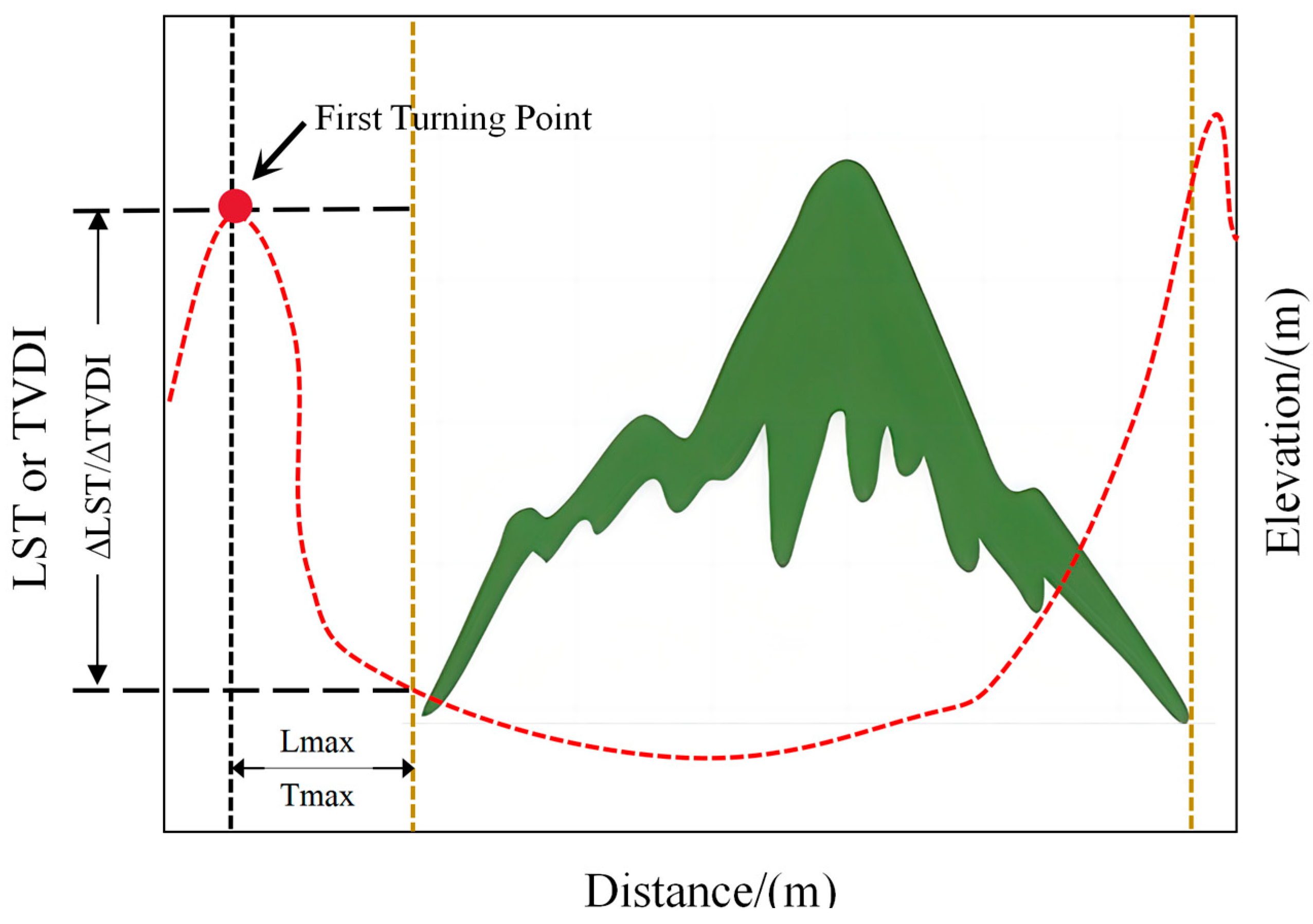
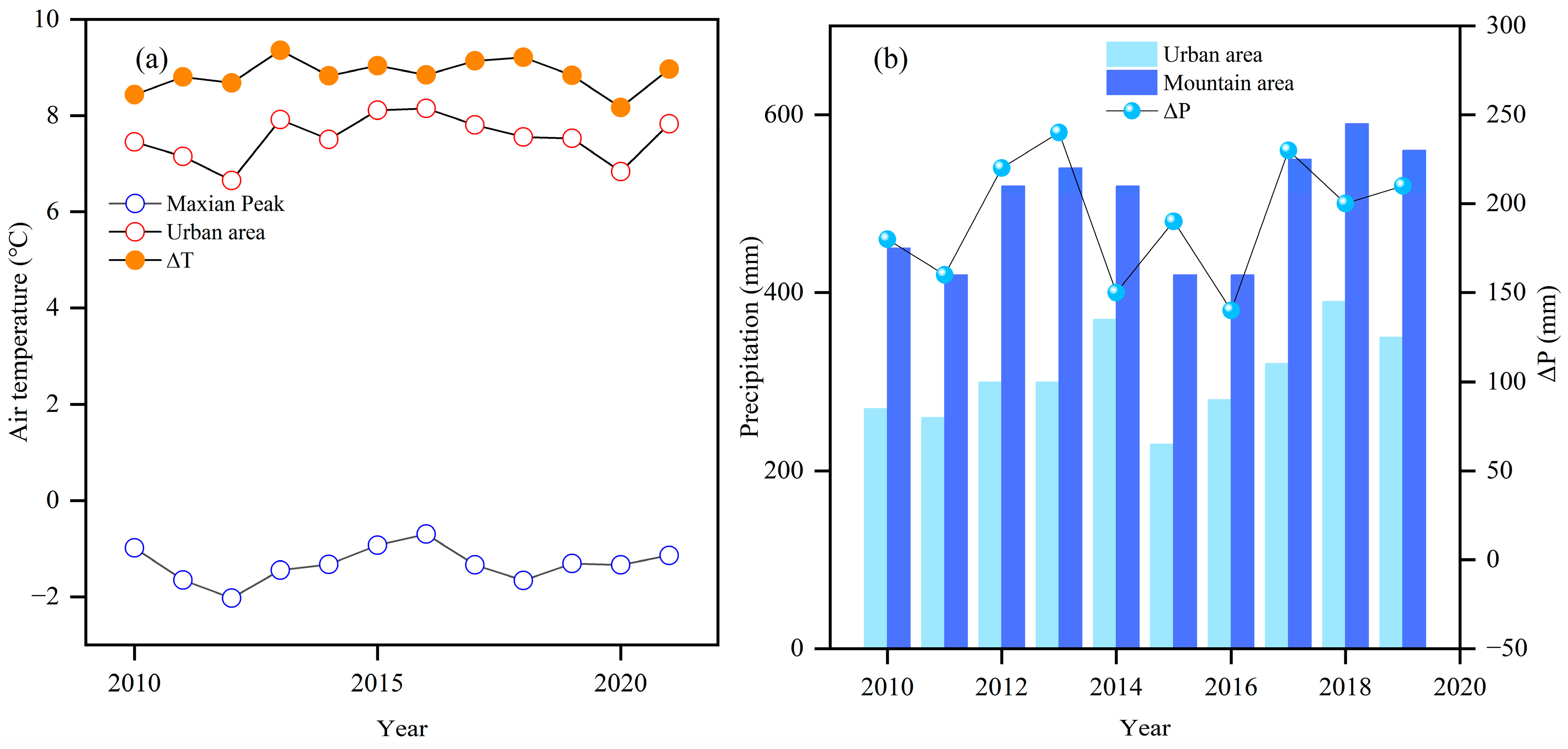

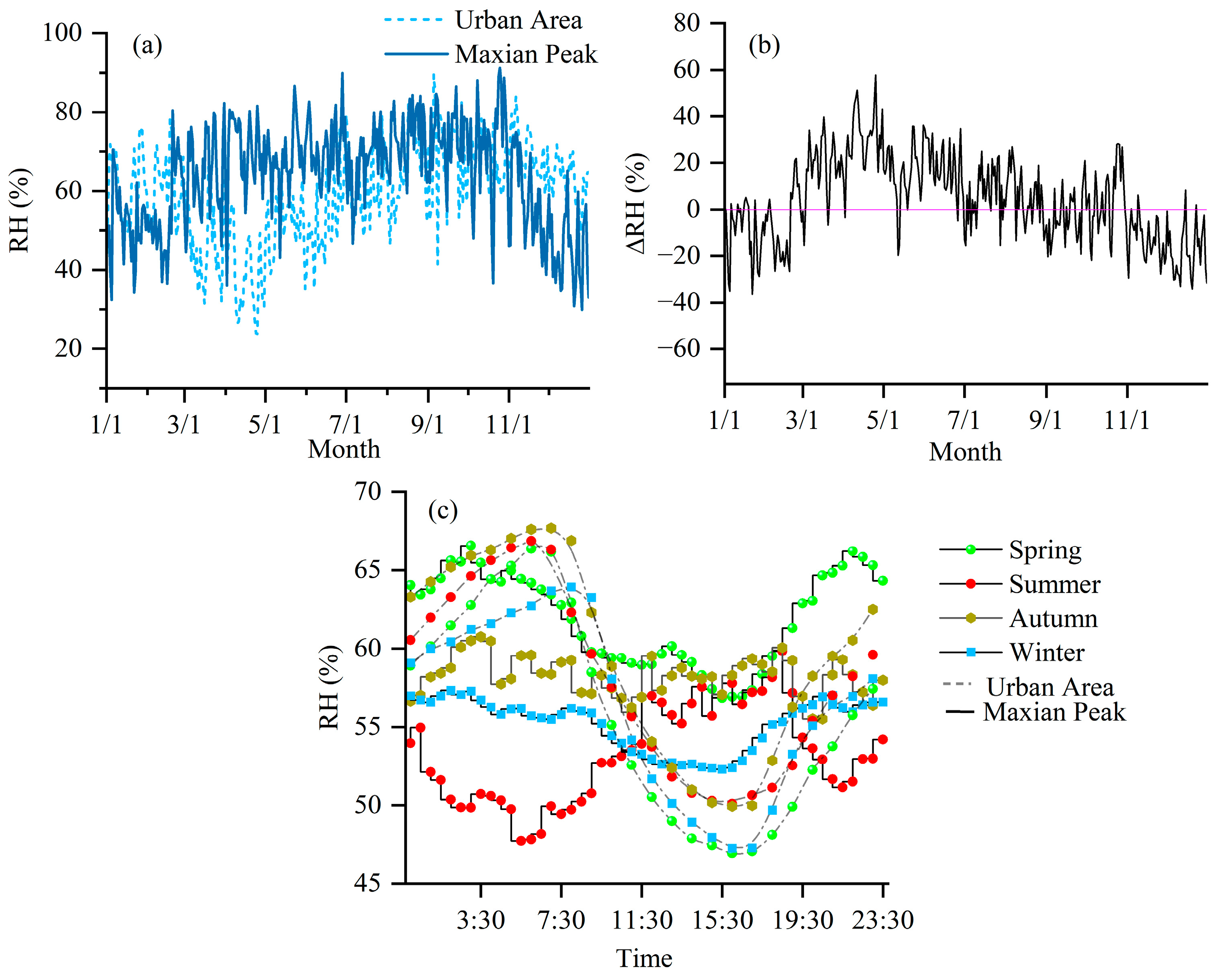
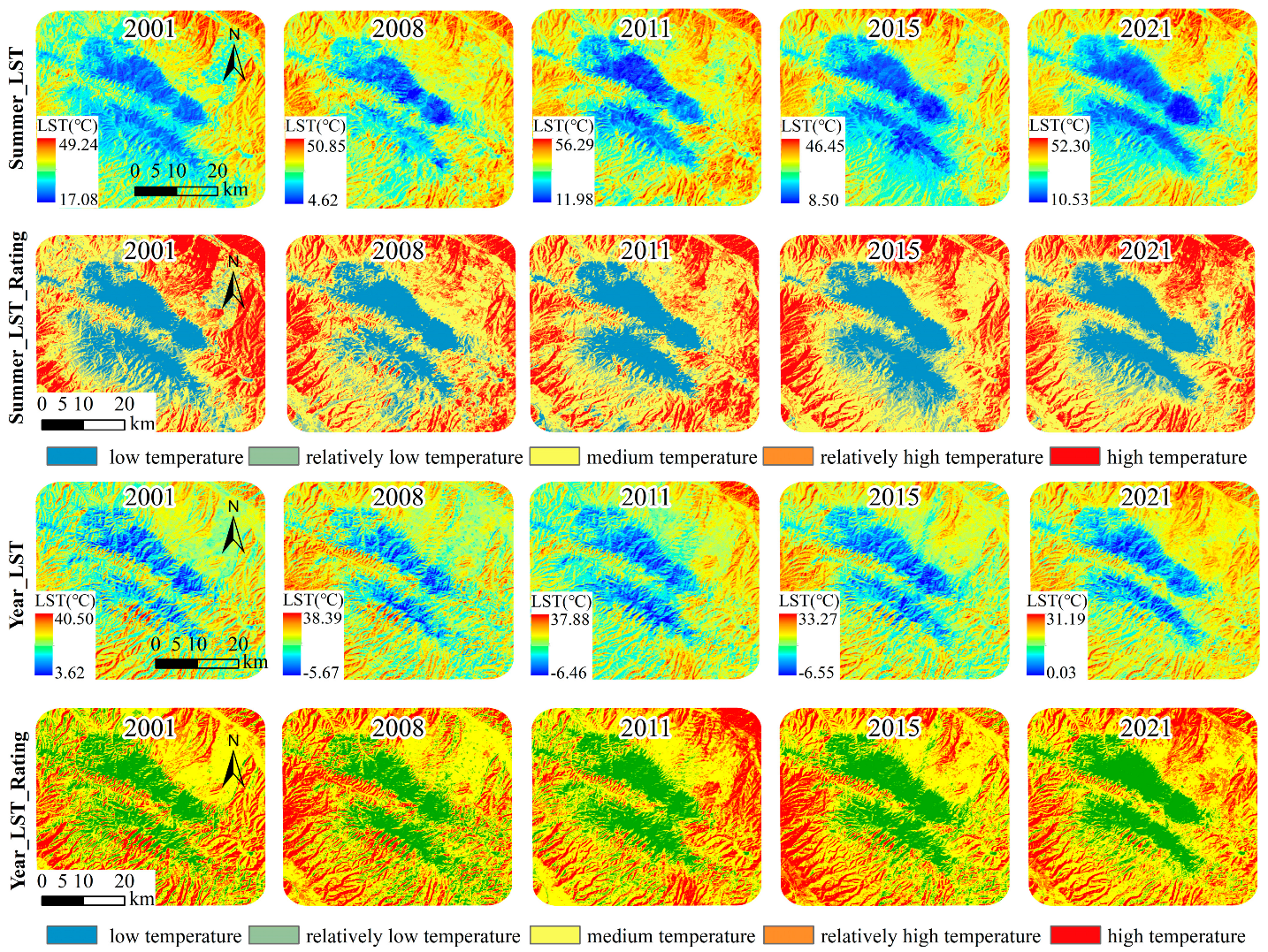

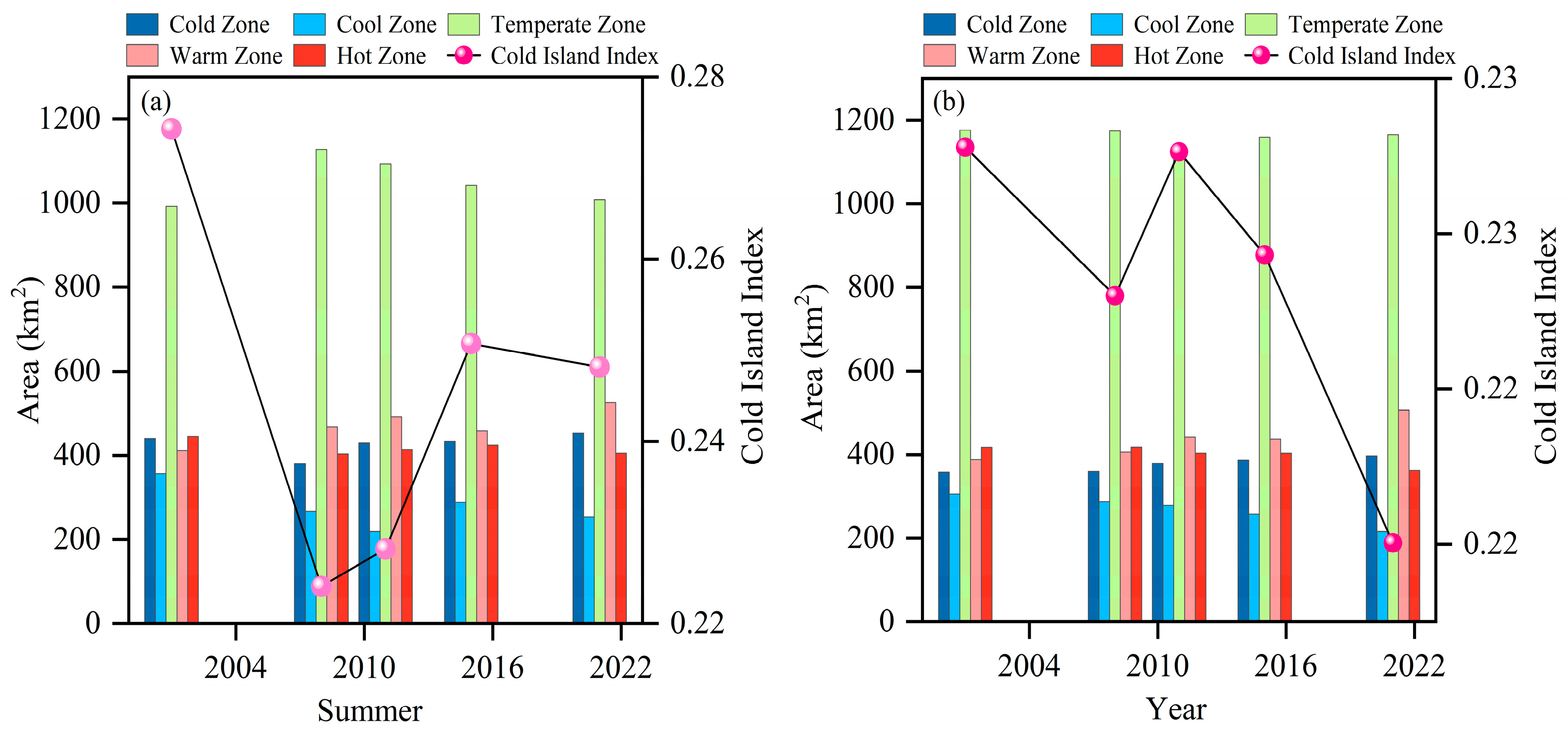
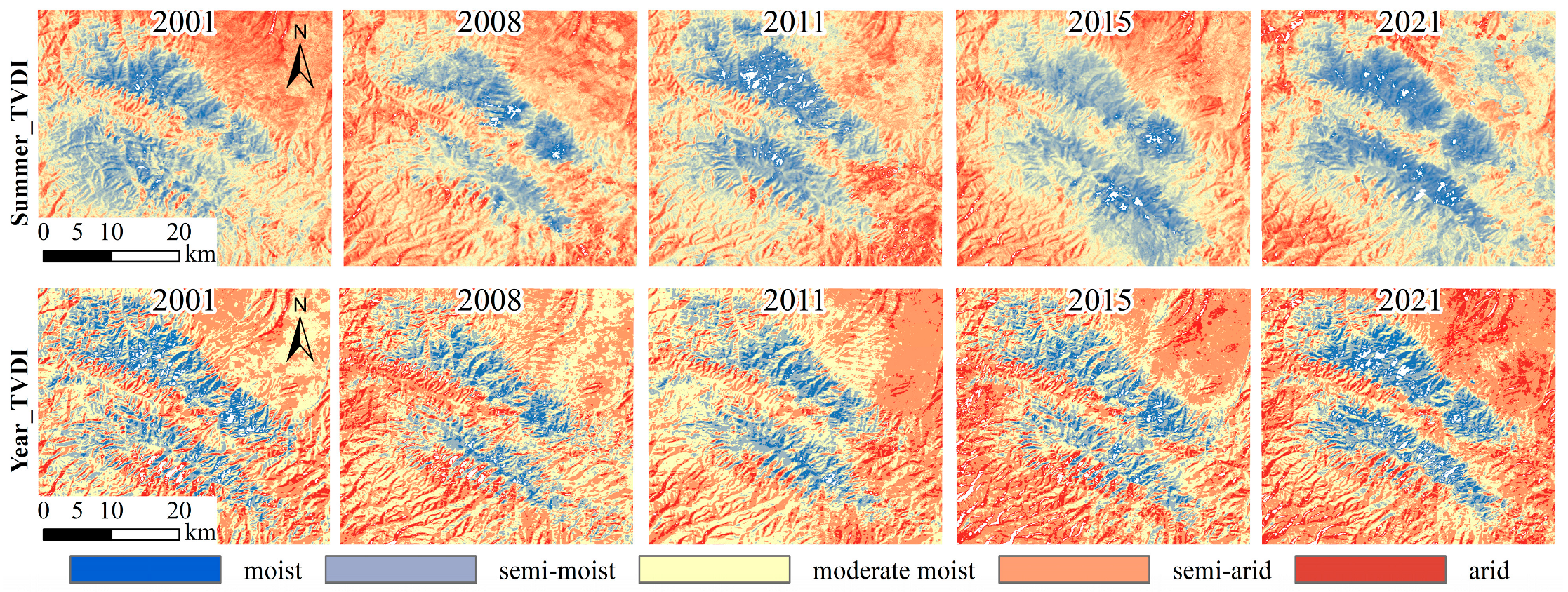

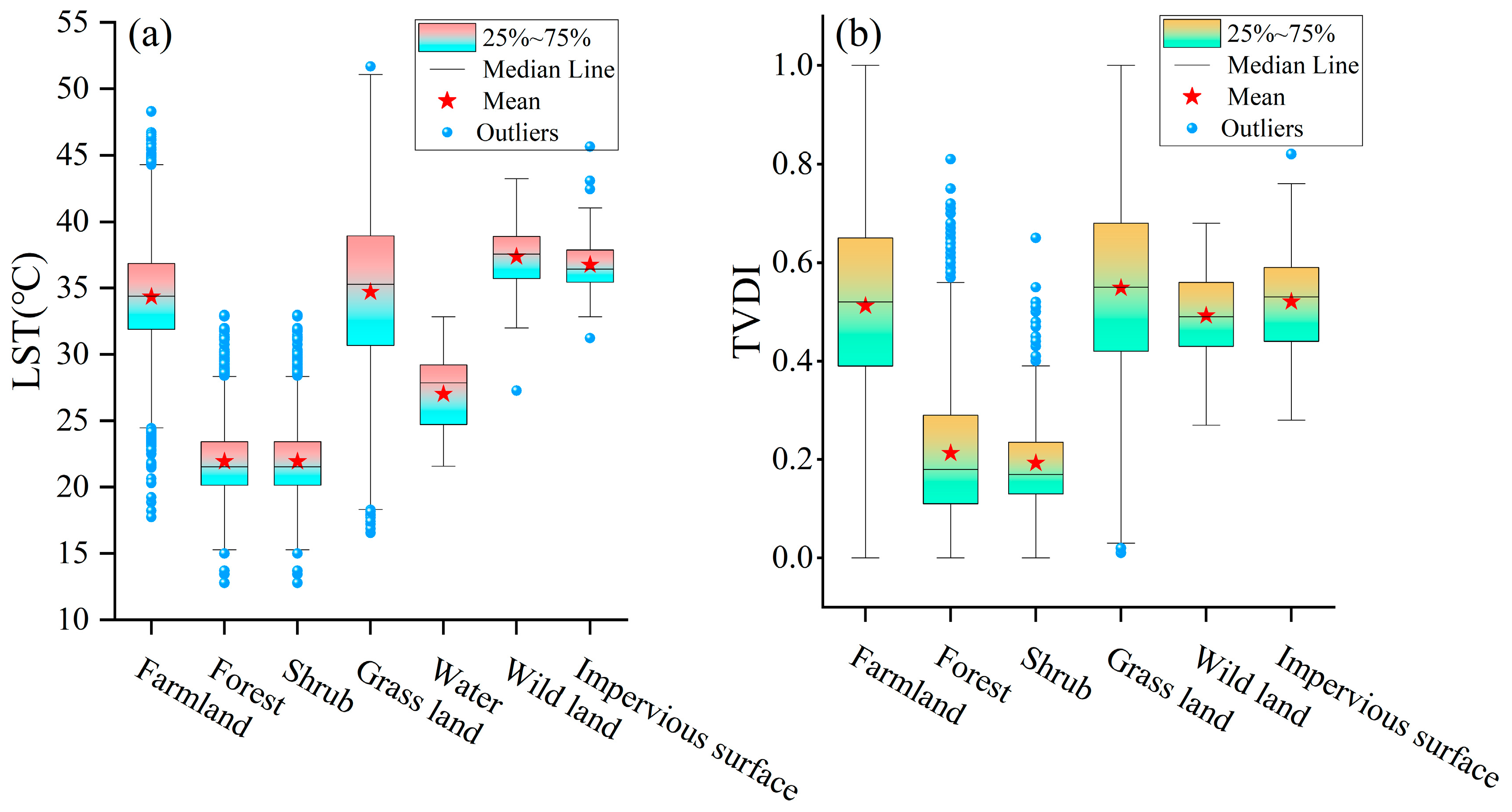

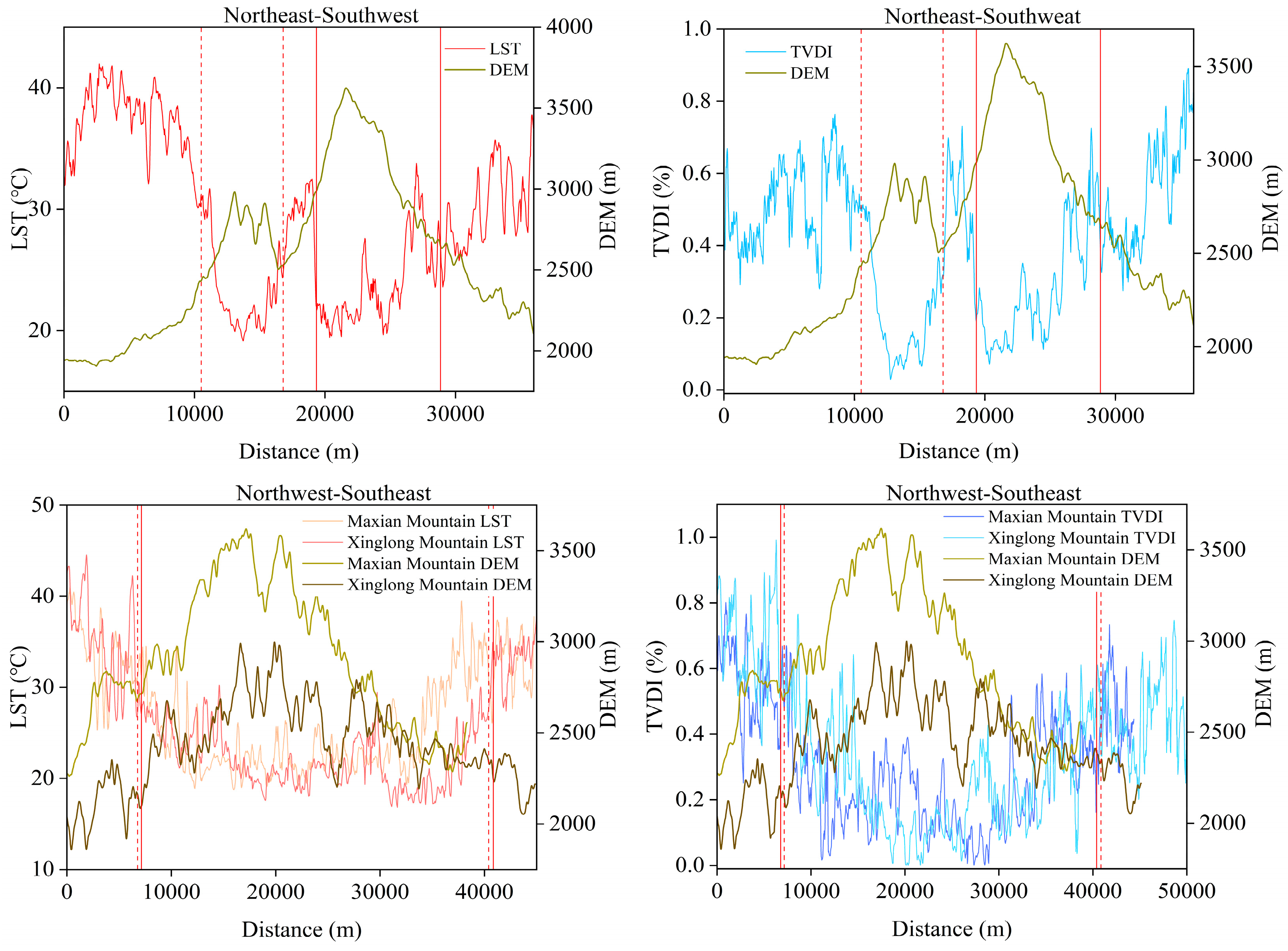
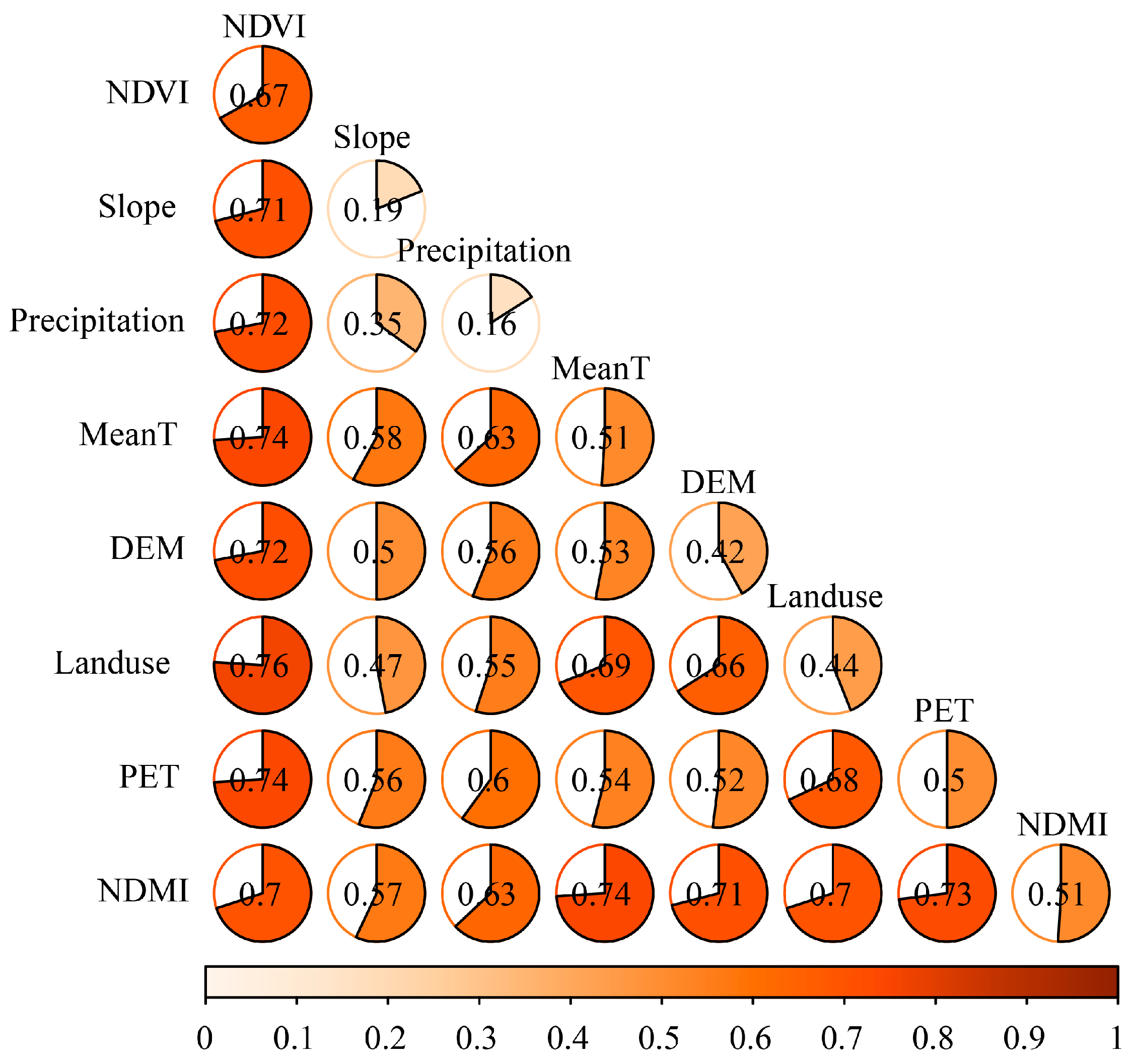
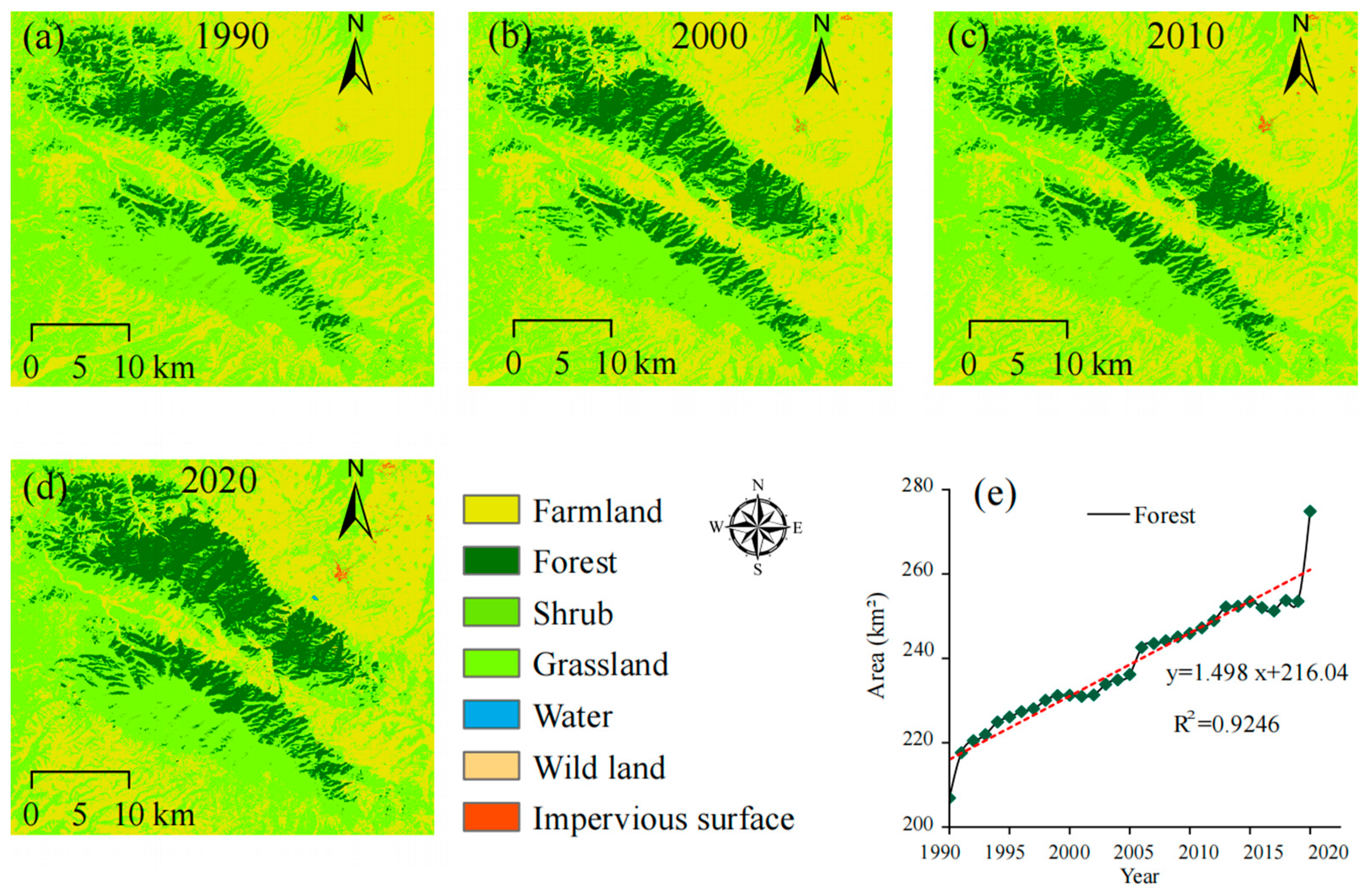
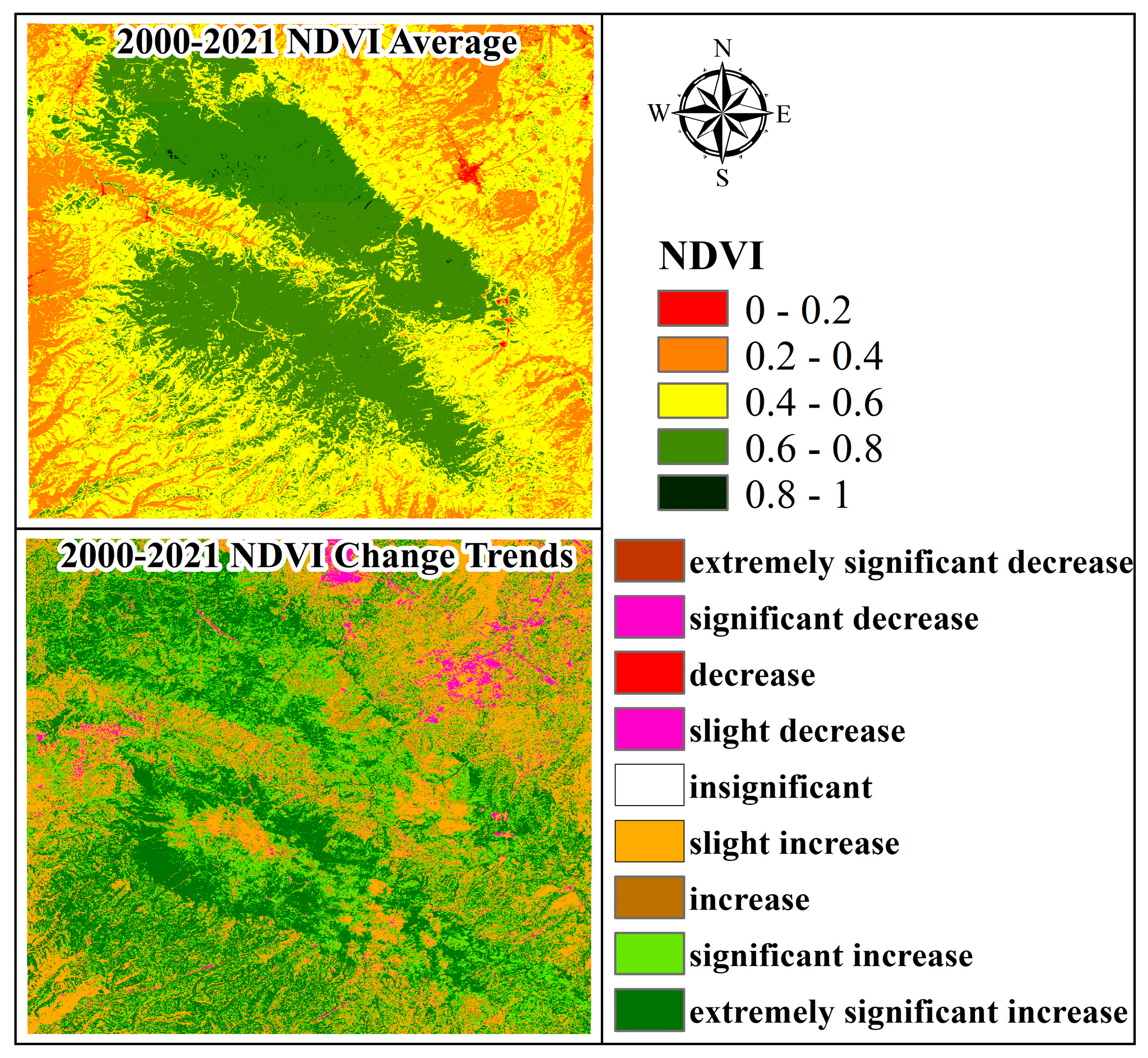
| Data Name | Sources | Resolution | Time Span | Data Source |
|---|---|---|---|---|
| Satellite | Landsat 5 TM | 30 m | 2001–2011 | https://earthexplorer.usgs.gov/, accessed on 2 December 2023 |
| Landsat 8 OLI/TIRS | 30 m | 2015–2021 | ||
| DEM | ASTER GDEM | 30 m | 2009 | https://search.earthdata.nasa.gov/, accessed on 10 October 2023 |
| Land Use | National Annual Land Cover Data CLCD (V1.0.2) | 30 m | 1990–2022 | https://doi.org/10.5281/zenodo.4417810, accessed on 1 September 2023 |
| Precipitation | ERA5 | 0.05° | 2010–2019 | https://cds.climate.copernicus.eu/cdsapp#!/dataset/reanalysis-era5-land?tab=form, accessed on 27 July 2023 |
| Station | Lon. (°E) | Lat. (°N) | Elevation (m) | Type |
|---|---|---|---|---|
| 52,983 | 104.1500 | 35.8667 | 1874 | Urban |
| TOA5 | 103.9693 | 35.7398 | 3566.20 | Maxian Peak |
| CR1,000 | 103.9632 | 35.735 | 3595.10 | Maxian Peak |
| Classification Level | LST Grading | Meaning (Relatively) | TVDI Grading | Meaning (Relatively) |
|---|---|---|---|---|
| 1 | NLST > u + std | high temperature | 0.8 < TVDI ≤ 1 | moist |
| 2 | u < NLST ≤ u + std | relatively high temperature | 0.6 < TVDI ≤ 0.8 | semi-moist |
| 3 | u − 0.5 std < NLST < u | medium temperature | 0.4 < TVDI ≤ 0.6 | moderate moist |
| 4 | u − std < NLST ≤ u − 0.5 std | relatively low temperature | 0.2 < TVDI ≤ 0.4 | semi-arid |
| 5 | LST < u − std | low temperature | TVDI ≤ 0.2 | arid |
| Interaction | Basis of Judgement |
|---|---|
| Nonlinear weaken | q(X1∩X2) < Min(q(X1), q(X2)) |
| Single-factor nonlinear weakening | Min(q(X1), q(X2)) < q(X1∩X2) < Max(q(X1), q(X2)) |
| Two-factor enhancement | q(X1∩X2) > Max(q(X1), q(X2)) |
| Independent | q(X1∩X2) = q(X1) + q(X2) |
| Non-linear enhancement | q(X1∩X2) > q(X1) + q(X2) |
| NDVI | Slope | Precipitation | MeanT | DEM | Landuse | PET | NDMI | |
|---|---|---|---|---|---|---|---|---|
| q statistic | 0.667183 | 0.191953 | 0.157864 | 0.508965 | 0.419612 | 0.443091 | 0.503126 | 0.512137 |
| p value | 0.000 | 0.000 | 0.000 | 0.000 | 0.000 | 0.000 | 0.000 | 0.000 |
Disclaimer/Publisher’s Note: The statements, opinions and data contained in all publications are solely those of the individual author(s) and contributor(s) and not of MDPI and/or the editor(s). MDPI and/or the editor(s) disclaim responsibility for any injury to people or property resulting from any ideas, methods, instructions or products referred to in the content. |
© 2024 by the authors. Licensee MDPI, Basel, Switzerland. This article is an open access article distributed under the terms and conditions of the Creative Commons Attribution (CC BY) license (https://creativecommons.org/licenses/by/4.0/).
Share and Cite
He, B.; Shangguan, D.; Wang, R.; Xie, C.; Li, D.; Cheng, X. Cold and Wet Island Effect in Mountainous Areas: A Case Study of the Maxian Mountains, Northwest China. Forests 2024, 15, 1578. https://doi.org/10.3390/f15091578
He B, Shangguan D, Wang R, Xie C, Li D, Cheng X. Cold and Wet Island Effect in Mountainous Areas: A Case Study of the Maxian Mountains, Northwest China. Forests. 2024; 15(9):1578. https://doi.org/10.3390/f15091578
Chicago/Turabian StyleHe, Beibei, Donghui Shangguan, Rongjun Wang, Changwei Xie, Da Li, and Xiaoqiang Cheng. 2024. "Cold and Wet Island Effect in Mountainous Areas: A Case Study of the Maxian Mountains, Northwest China" Forests 15, no. 9: 1578. https://doi.org/10.3390/f15091578






